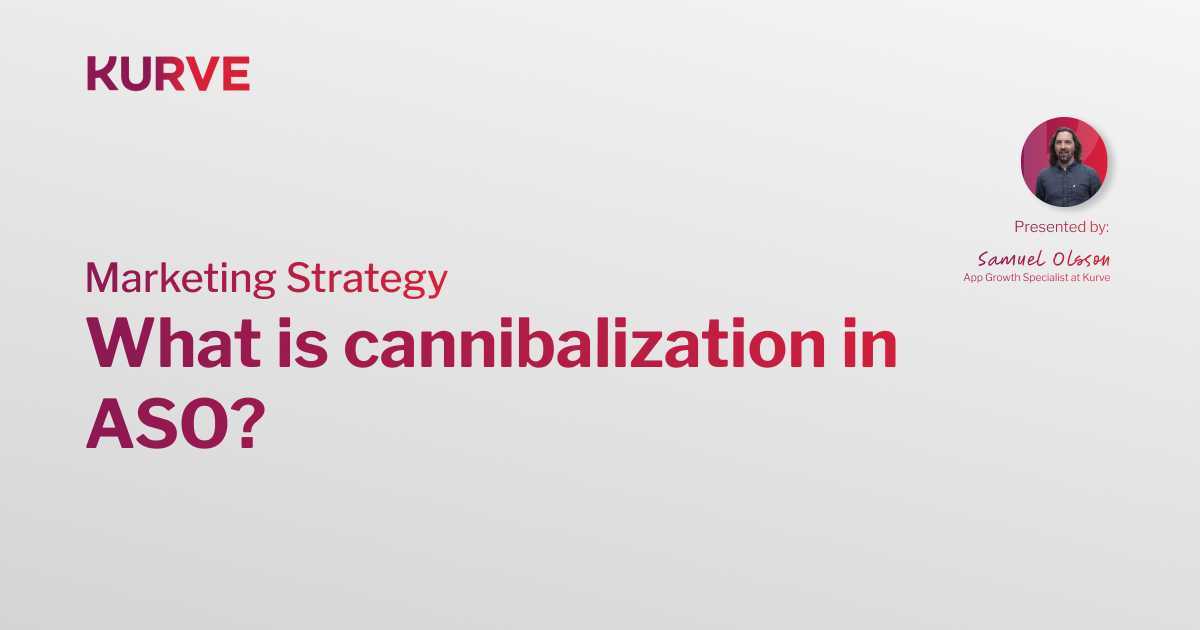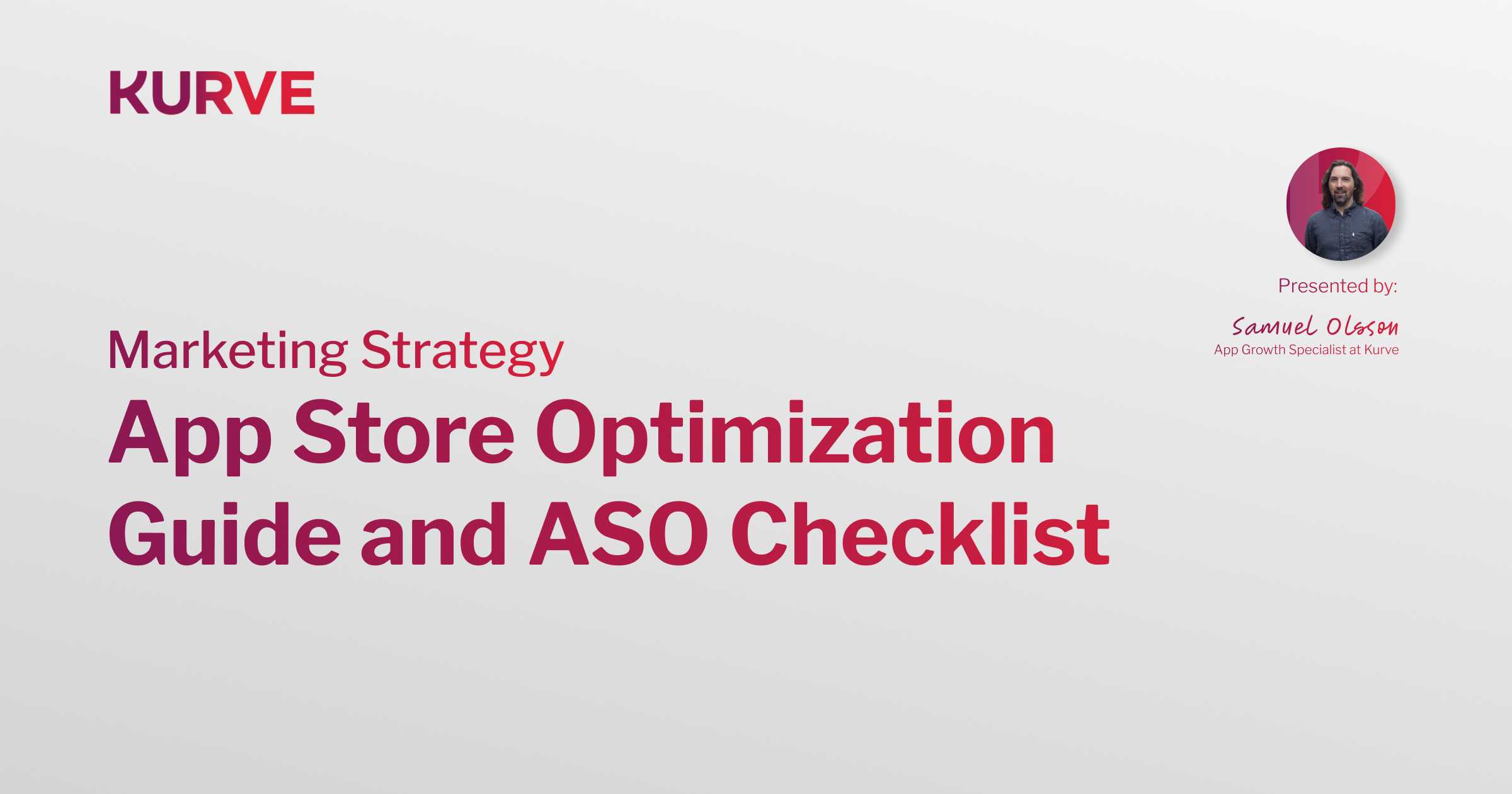What is Mobile App Localization? Types and Strategies
App localization is a crucial step in reaching a global market of mobile phone users.
But what is it exactly? App localization is tailoring your app to fit many languages, cultures, languages and locales. It's more than translation; it considers regional regulations, cultural nuances and local preferences.
A well-localized app resonates with users, improves user experience, increases app downloads, and leads to more global success.
As we discuss localization, understanding how to optimize apps for search engines becomes essential. If you want to see how SEO can amplify your app's visibility, check out our previous post.
What is App Localization?
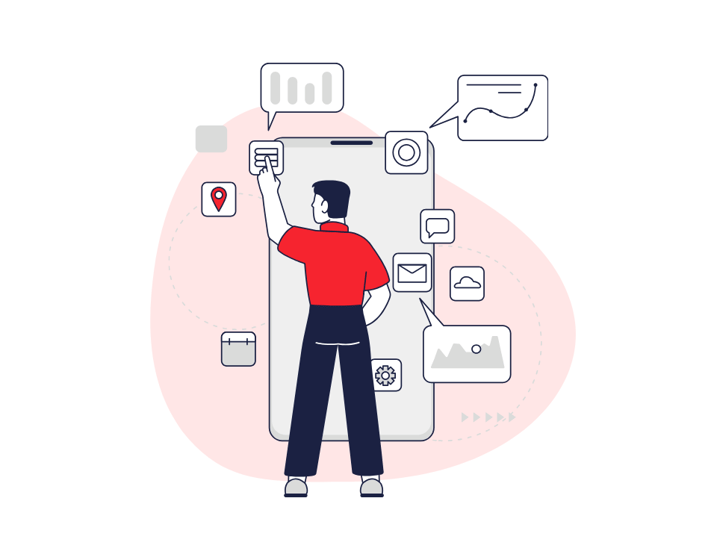
App localization is about adapting your app to fit specific regions or cultures. It's not a translation task— it's a transformation process. It aims to make a globally functional app resonate with local users.
Localizing your app impacts the Key Performance Indicators (KPIs) you rely on to track your app's success.
This crucial process rests on three fundamental principles:
- Cultural adaptation
- Technical adaptation
- Visual and graphic adaptation
Cultural Adaptation
Cultural sensitivity is a must when localizing your app.
Consider the symbolism and connotations of colors, for instance. White often symbolizes purity or innocence in the West, while in East Asia, it can be associated with mourning.
A mismatch in cultural interpretation can send the wrong message and alienate your users.
Your app has to respect and resonate with the local norms, customs, and sentiments. It's all about giving your users a culturally familiar experience in the digital sphere.
Technical Adaptation
Different regions will have different standards and regulations. A one-size-fits-all approach is going to take a lot of work.
You must adapt to local date and time formats, number formats, and currency localization. For example, if you're in the US, you'd see the date as mm/dd/yyyy. But switch to the UK, and you'll see dd/mm/yyyy.
These might seem minor, but such details influence user experience.
Visual and Graphic Adaptation
Visual adaptation is another critical aspect of the mobile app localization process. Graphics, images, and visual cues should align with the cultural expectations of each local market.
For instance, you might need to change a familiar Western icon that could be misunderstood in another culture. Also, note that humor or references in visuals may not land in other cultures.
Additionally, graphic adaptation comes with its own set of challenges. One challenge is fitting translated text into existing visuals without disrupting the user interface. Languages vary in length and structure; you must accommodate these variations while preserving an enjoyable user experience.
Why Localize Your App?
Localizing your app can provide various benefits, the key being the power to break language barriers. By doing so, your app can tap into new markets, reaching users who might have been inaccessible.
When you localize, you enhance user satisfaction. It's easier for users to interact with apps in their native tongue, which leads to improved user experience.
Savvy businesses have seen the transformative impact of app localization. Their success stories can show you why you should consider localization.
Now, we'll break down the specific advantages of app localization. We'll demonstrate its crucial role in fostering user experience, boosting market penetration, building competitive edge, and facilitating higher conversion rates.
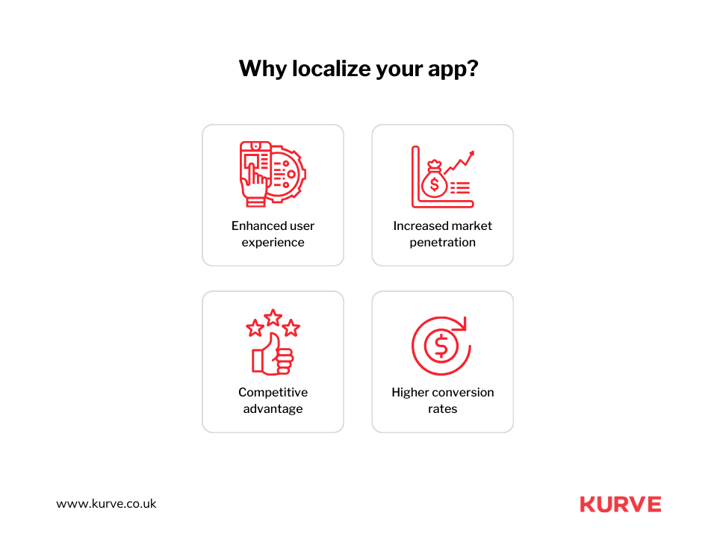
Enhanced User Experience
By localizing your app, you deliver a more tailored and intuitive experience. Users appreciate when an app adheres to their cultural nuances and language preferences. After all, familiarity fosters satisfaction and increases the probability of continued use.
Increased Market Penetration
Localization allows your app to break into previously untouched markets. It's an avenue to global prevalence, helping cater to diverse user bases. An app in a user's native language breaks down barriers, increasing its accessibility for non-English native speakers or those who prefer using their first language.
Competitive Advantage
Being a front-runner in localizing your app in a particular market can bring notable advantages. Aligning with local users' preferences can foster stronger brand loyalty, creating a resilient connection with your users. This strategic move can put you ahead of the competition.
Higher Conversion Rates
Localized apps tend to see higher user engagement and improved download rates in targeted regions. Whether it's increased in-app purchases or heightened ad engagement, a tailored user experience contributes to elevated conversion rates.
Types of Mobile App Localization
When it comes to localizing your app, there are two main approaches:
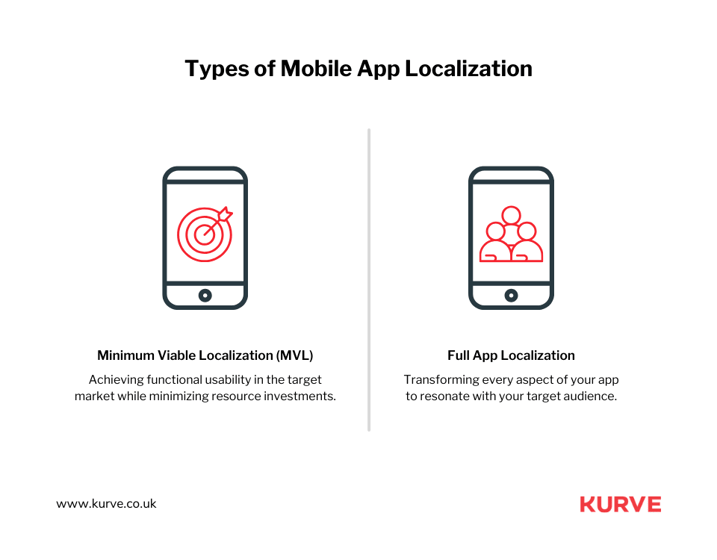
- Minimum Viable Localization (MVL)
- Full App Localization
Each has its benefits and drawbacks, depending on your goals and resources. Let's explore these two types, helping you decide which approach best aligns with your app's needs.
Minimum Viable Localization (MVL)
The MVL approach is about balancing your localization effort. It's about achieving functional usability in the target market while minimizing resource investments. It's a focused adaptation, one could say.
Of course, there's an appeal to this type of localization. It's cost-effective, requiring only the resources, and promises a quick implementation.
But there is a trade-off.
It tends to have limited cultural customization and may mean a less personalized user experience than its full localization counterpart.
Focused Adaptation
With MVL, priority is given to translating and adapting only key elements essential to making your app usable in the target market. It's about prioritizing resources to gain a foothold in the local user segment you're reaching out to.
Cost-Effective
The MVL approach allows for localization even on a limited budget. You work within your means, focusing resources on adapting the bare essentials of your app to function in the target market.
Quick Implementation
Because you're only dealing with crucial elements for adaptation, MVL means quicker implementation. This speedy turnaround allows you to stay competitive and seize opportunities promptly in the ever-evolving global mobile app markets.
Limited Cultural Customization
While the MVL approach does ensure functional usability, it may only partially address some cultural nuances specific to the local market. MVL works to make your app work without necessarily integrating comprehensive cultural elements of the target locale.
Full App Localization
For many organizations, Minimum Viable Localization is the starting point. Moving further, we come to Full App Localization, which is more intensive and rewarding.
Full localization is about transforming every aspect of your app to resonate with your target audience.
From the app's user interface to in-app content, this approach makes your mobile app feel like it was initially developed in the target market's language and keeps its cultural nuances in place.
It ensures an immersive and personalized user experience, making your app more appealing to users in specific markets.
Yet, the resource intensity required is a crucial aspect to consider with this approach.
Comprehensive Adaptation
Full localization means customizing every app component to resonate with your target market. Language, visuals, interfaces – everything is customized to align with your users' aesthetic and functional preferences in the target locale. This level of adaptation fosters a strong sense of familiarity.
Deeper Cultural Integration
Full localization goes beyond simple translation. All visuals, symbols, and cultural references must reflect the target audience's culture. The goal is to culturally integrate your app, making it feel natural and native to its users.
Enhanced User Experience
A fully localized app provides a seamless and natural interface — like a favorite local spot. This results in higher user satisfaction, boosting engagement rates. Users feel at home with your app, leading to higher retention rates.
Full localization heightens the user experience.
Resource-Intensive
While effective, Full localization requires substantial time, budget, and resources. Its comprehensive nature means attending to various elements of the entire app, from language to visuals to cultural peculiarities. But remember, it's an investment toward a more successful localized app experience.
App Localization Strategies
Before starting your app localization process, it's essential to have a smooth process. Here's the high-level roadmap we recommend for it:
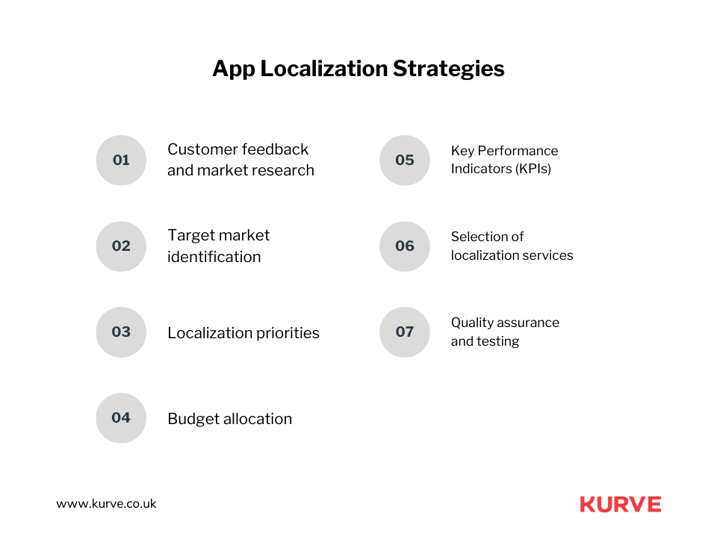
- Customer feedback and market research: Begin with user insights; know your audience's needs and preferences.
- Target market identification: Use your research; identify where and who your users are.
- Localization priorities: Determine what needs localizing: user interface, content, or your app's icons.
- Budget allocation: Plan finances, keeping potential returns in view.
- Key Performance Indicators (KPIs): Identify KPIs; you'll need these to monitor localized performance.
- Selection of localization services: Choose the best services aligned with your app's requirements and budget.
- Quality assurance and testing: Remember to run thorough tests and quality assurance checks on your localized app version.
Now, let's dig deeper into each step, one at a time.
Customer Feedback and Market Research
With app localization, incorporating customer feedback and market research is a smart first move.
Use feedback to understand how your users interact with your app. It's about more than identifying bugs. What kind of experience are they seeking? Are there cultural nuances missing? You aim to fulfill your users' needs, clearing any hurdles.
And then, there's market research. It's broader in scope than app analytics, helping you understand the market behavior and competition around you. Notice the common trends? What are other apps in the locale doing that makes them successful? Cultural preferences can differ from one market to another.
Combining these two approaches presents a holistic understanding of your user's needs and market dynamics. You're offering them an experience they would love to return to over and over again.
Our ASO Best Practices guide could come in handy as you navigate through your user feedback and market intelligence. It's packed with insights on reflecting your users' needs and market trends in your app optimization strategies.
Target Market Identification
Identifying your target market is a critical element. It is geared towards making a more efficient use of your resources and driving your app towards success in the selected locales.
Using your market research, pinpoint with precision where and who your users are. Recognize their behavioral patterns and preferences to make your localization efforts more impactful. Plan your resources based on these insights.
For practical guidance on resource allocation and successful app localization, refer to our ASO checklist. Keep your sights set on optimizing your app's presence in the global market with a well-tailored app localization strategy.
Localization Priorities
Once you've identified your target market, prioritizing your localization tasks comes into play. The goal is to adapt the most vital elements of your app for your chosen markets. It's about creating an environment where users feel right at home.
Consider the minor details contributing to the user experience when setting your localization priorities. For instance, how friendly would an app icon designed initially for a Western audience be to Asian users? A minor tweak can heighten user engagement.
Our app icon optimization resource will be useful if you need guidance.
By tailoring each element of your app to suit each region's cultural norms and expectations, you create a sense of familiarity and belonging - a key to successful app localization.
Budget Allocation
We've spoken about location, culture, and metrics, but how about the financial aspect?
The budget allocation for your localization process plays a pivotal role. The challenge is allocating funds to areas needing them the most. Our helpful guide on the best practices for App Store Optimization reveals some crucial aspects of budget allocation.
Remember, it's not about how much you spend. It's how you spend it.
Key Performance Indicators (KPIs)
Gauging the success of your efforts is critical to localizing your app, and that's where KPIs step in.
KPIs offer measurable reflections of how well your strategies are translating into results. From increased downloads in targeted regions to better user engagement, these metrics serve as a compass guiding your ongoing efforts.
Consider aspects like costs associated with app store optimization and localization work. These could form a part of your KPIs; you can find more about them here.
Selection of Localization Services
Choosing appropriate partners or tools for the app localization process is crucial. Pairing your strategy with the right localization services can make a notable difference.
If you glance at some ASO case studies, you'll see that success often stems from making savvy choices when picking localization tools or partners.
Securing the right tool or partner bolsters your app translation and localization process. You also enhance the chances of your app hitting the right note with your target market.
Quality Assurance and Testing
For your mobile app internationalization to succeed, bugs have no place. A localized app must also be user-friendly in design. You can trace the root of these features to robust testing and vigorous quality assurance efforts.
This ASO checklist includes essential steps for quality assurance and testing. It highlights the significance of validating each element of your localized app for a seamless experience.
Addressing glitches, inconsistencies in language, or formatting can enhance your app's performance. It also leads to higher user satisfaction, paving the path to global success for your app.
Expanding Reach through Localization
Mobile app localization is a careful process of cultural, technical, and visual adaptations that cater to specific user experiences.
The little details – the symbolism of colors, modifications in visual cues, and conforming to local date and time formats – can enhance the user experience. Localization can ensure your app harmonizes with local customs and norms and dial-up those all-important KPIs.
While app localization is an investment, it can pay off handsomely when considering the costs associated with ASO.
Only through effective localization can your app encapsulate the global user experience.
So, why wait? It's time to explore this valuable strategy and see how it can elevate your mobile apps to a whole new level of global audience and user engagement.
